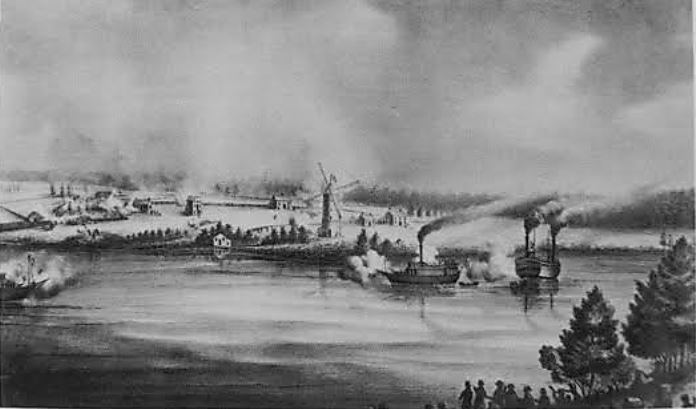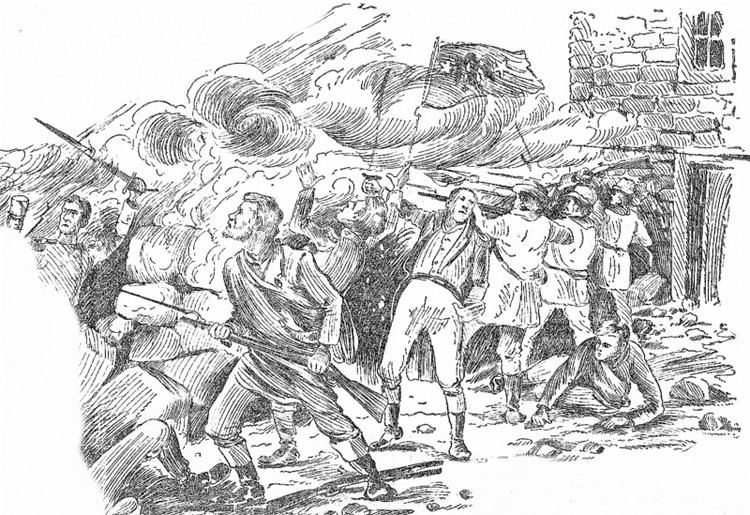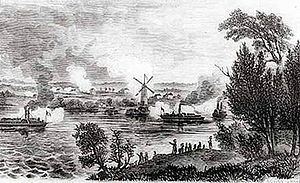53 dead61 wounded136 captured 17 dead60 wounded | Dates 12 Nov 1838 – 16 Nov 1838 Combatants Canada, United Kingdom | |
 | ||
250 Hunter insurgents British1,133 Canadian militia500 British regularsRoyal NavyAmericanU.S. ArmyU.S. Navy Results Anglo-American victory;, Defeat of insurgent invasion Similar Upper Canada Rebellion, Rebellions of 1837, Battle of Windsor, Battle of Montgomery's Tavern, Battle of Crysler's Farm | ||
Exploring battle of the windmill historic site near prescott
The Battle of the Windmill was a battle fought in November 1838 in the aftermath of the Upper Canada Rebellion. Loyalist forces of the Upper Canadian government and American troops, aided by the Royal Navy and U.S. Navy, defeated an invasion attempt by Hunter Patriot insurgents based in the United States with the intention of using it as a leap pad for offensives into Canada. Consequently, American and British troops thwarted them while defending Canadian soil and forced them back down south into the United States, where they were captured and arrested by U.S. officials.
Contents
- Exploring battle of the windmill historic site near prescott
- Battle of the windmill
- Background
- Attempted seizure of Prescott
- First assault
- Second assault
- Aftermath
- References

Battle of the windmill
Background

After the first rebellion by disaffected Upper Canadians was suppressed in 1837, the majority of the rebel leaders fled to the United States. Popular sentiment in the States believed that the Canadians were eager to overthrow British rule and form a republic patterned after the American model, and an organization known as the Hunter Patriots was formed to assist the rebellion. Organized in neo-Masonic secret lodges, and with widespread support in the northern border states from Vermont to Wisconsin, the Patriot Hunters aimed to invade Canada and lead an army of insurgent Canadians against the British colonial government. In reality, much of the Canadian population was loyal to existing British institutions and decidedly against the prospects of revolution or invasion.

In November 1838, a group of Hunter Patriots decided that it was time to invade Canada and restart the rebellion. They chose as their target the town of Prescott, on the north bank of the St. Lawrence River downriver from Kingston. Prescott is the site of Fort Wellington, a British military fortification which commanded the St. Lawrence River and which was serving as a fortified depot for the Upper Canadian militia. To initiate the strike, a large group of Hunters assembled in Sackets Harbor, New York and descended the river to Ogdensburg in civilian vessels. Overall military command of the insurgent forces was held by John Birge, a senior member of the Hunter organization in New York state.
Attempted seizure of Prescott
Early in the morning of November 12, a force of about 250 men attempted to land in Prescott. However, the British had infiltrated the Hunter organization, and had advance warning of the attack. With the element of surprise gone, and with the town militia ready to repel a landing, the Hunter forces were forced to abandon the landing. Both vessels ran aground on a mud flat where the Oswegatchie River flows into the St. Lawrence off Ogdensburg.
Later in the morning, Bill Johnston, Admiral of the Hunter navy, arrived and succeeded in freeing the stranded vessels, which ran downriver to Windmill Point, a promontory located approximately two miles east of Prescott. Here, most of the Hunter forces landed to occupy the hamlet of Newport and its most prominent feature, a large, stone windmill building which enjoyed a panoramic view of the St. Lawrence River as far west as Brockville and eastwards over the Gallop Rapids. The commanders of the Hunters appointed a Polish immigrant with some military experience, Nils von Schoultz, to command the Hunter forces while the Hunter leadership withdrew to Ogdensburg to collect reinforcements and supplies.
First assault
The windmill was built of thick stone and stood 60 feet (18 m) high on top of a 30-foot (9.1 m) bluff. Although the structure had not been intended to play a role in the invasion, it was an ideal field fortification. Its height would prevent the British forces from approaching unobserved, and its thick stone walls were impervious to small arms and to small field and naval artillery. Early on the morning of 13 November, a force under the command of the militia officers Colonel Plomer Young, Colonel Richard Fraser, and Colonel Ogle Gowan and comprising a handful of British infantry from the 83rd Regiment and approximately 600 Canadian militiamen invested the Hunter position around Newport. Their attack failed, leaving 13 regulars and militiamen killed along with 70 wounded. Approximately 18 Hunters were also killed along with an unknown number of wounded.
The next several days were a standoff. As time passed, von Schoultz's position had become desperate. Promised reinforcements and supplies never arrived as the United States Navy aided the Royal Navy in blocking egress from Ogdensburg. Law enforcement and military officials in Ogdensburg secured all of the available vessels, and most of the prominent Hunter leaders fled from town to avoid arrest.
Second assault
With the arrival of heavy artillery from Kingston, as well as sizeable detachments of British Army regulars, Canadian militia and U.S. Army regulars, the final attack began with an artillery bombardment of the windmill on November 16. With Royal Navy gunboats and steamers, and support from the U.S. navy, the Hunters were blocked from escaping and casualties were mounting, so von Schoultz decided to unconditionally surrender.
Aftermath
In the aftermath of the battle, almost all of the Hunters were captured and were transported to Kingston for trial. Eleven people, including the Hunter leader Nils von Schoultz, were executed; another 60 were sentenced to transportation to Australia. 40 were acquitted, and another 86 were later pardoned and released. Von Schoultz enjoyed the legal counsel of John A. Macdonald, a prominent young Kingston lawyer who would later become the architect of Canada's Confederation in 1867 and the nation's first Prime Minister.
The site of the battle was designated a National Historic Site of Canada in 1920.
